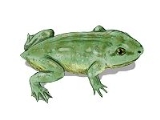
Triadobatrachus
Encyclopedia
Triadobatrachus is an extinct genus of frog
-like amphibian, including only one known species, Triadobatrachus massinoti. It is the oldest frog known to science
, and an excellent example of a transitional fossil
. It lived during the Early Triassic
, in what is now Madagascar
.
 Triadobatrachus was 10 centimetres (3.9 in) long, and still retained many primitive characteristics, such as possessing fourteen vertebrae, where modern frogs have only four to nine. Six of these vertebrae formed a short tail, which the animal retained as an adult. It probably swam by kicking its hind legs, although it could not jump, as most modern frogs can. Its skull
Triadobatrachus was 10 centimetres (3.9 in) long, and still retained many primitive characteristics, such as possessing fourteen vertebrae, where modern frogs have only four to nine. Six of these vertebrae formed a short tail, which the animal retained as an adult. It probably swam by kicking its hind legs, although it could not jump, as most modern frogs can. Its skull
resembled that of modern frogs, consisting of a latticework of thin bones separated by large openings. As evidenced by its large ear
openings, Triadobatrachus possessed good hearing.
This creature, or a cousin, evolved eventually into modern frogs, the earliest example of which is Sanyanlichan
, millions of years later in the late Jurassic
.
It was first discovered on 1937, when Adrien Massinot, near the village of Betsieka in northern Madagascar
, found an almost complete skeleton. The animal must have fossilized soon after its death, because all bones lay in their natural position. Only the anterior part of the skull and the ends of the limbs were missing.
Although it was found in marine deposits, the general structure of Triadobatrachus shows that it may have lived for part of the time on land and breathed air. Its proximity to the mainland is further borne out by the remains of terrestrial plants found together with it.
Frog
Frogs are amphibians in the order Anura , formerly referred to as Salientia . Most frogs are characterized by a short body, webbed digits , protruding eyes and the absence of a tail...
-like amphibian, including only one known species, Triadobatrachus massinoti. It is the oldest frog known to science
Science
Science is a systematic enterprise that builds and organizes knowledge in the form of testable explanations and predictions about the universe...
, and an excellent example of a transitional fossil
Transitional fossil
A transitional fossil is any fossilized remains of a lifeform that exhibits characteristics of two distinct taxonomic groups. A transitional fossil is the fossil of an organism near the branching point where major individual lineages diverge...
. It lived during the Early Triassic
Early Triassic
The Early Triassic is the first of three epochs of the Triassic period of the geologic timescale. It spans the time between 251 ± 0.4 Ma and 245 ± 1.5 Ma . Rocks from this epoch are collectively known as the Lower Triassic, which is a unit in chronostratigraphy...
, in what is now Madagascar
Madagascar
The Republic of Madagascar is an island country located in the Indian Ocean off the southeastern coast of Africa...
.

Skull
The skull is a bony structure in the head of many animals that supports the structures of the face and forms a cavity for the brain.The skull is composed of two parts: the cranium and the mandible. A skull without a mandible is only a cranium. Animals that have skulls are called craniates...
resembled that of modern frogs, consisting of a latticework of thin bones separated by large openings. As evidenced by its large ear
Ear
The ear is the organ that detects sound. It not only receives sound, but also aids in balance and body position. The ear is part of the auditory system....
openings, Triadobatrachus possessed good hearing.
This creature, or a cousin, evolved eventually into modern frogs, the earliest example of which is Sanyanlichan
Sanyanlichan
"Sanyanlichan" is the name given to a fossil that represents the earliest known "modern" frog. The fossil dates to approximately 125 million years ago , and was found in the fossil beds of Sihetun, in the western part of Liaoning province, China...
, millions of years later in the late Jurassic
Jurassic
The Jurassic is a geologic period and system that extends from about Mya to Mya, that is, from the end of the Triassic to the beginning of the Cretaceous. The Jurassic constitutes the middle period of the Mesozoic era, also known as the age of reptiles. The start of the period is marked by...
.
It was first discovered on 1937, when Adrien Massinot, near the village of Betsieka in northern Madagascar
Madagascar
The Republic of Madagascar is an island country located in the Indian Ocean off the southeastern coast of Africa...
, found an almost complete skeleton. The animal must have fossilized soon after its death, because all bones lay in their natural position. Only the anterior part of the skull and the ends of the limbs were missing.
Although it was found in marine deposits, the general structure of Triadobatrachus shows that it may have lived for part of the time on land and breathed air. Its proximity to the mainland is further borne out by the remains of terrestrial plants found together with it.

